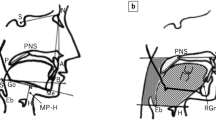Abstract
The aims of this study were to evaluate patients with obstructive sleep apnea syndrome (OSAS) with regards to dysanapsis (airway size relative to lung size) and to demonstrate the differences between the patients with and without extrathoracic airway obstruction. The study population consisted of 15 patients with OSAS and 14 age and body mass index (BMI) matched control subjects. OSAS patients and control subjects showed similar characteristics in FEV1, FEV1/FVC, FEF25–75, and FEF25–75/FVC ratios. Expiration reserve volume was significantly higher in the control group than in OSAS patients (p<0.01). Six patients exhibited extrathoracic airway obstruction while awake. Of these, three had also a sawtooth pattern in their flow–volume curves. The remaining nine patients had no extrathoracic airway obstruction and had lower apnea–hypopnea indexes (AHI) than the obstruction group (p<0.05). OSAS patients and age- and BMI-matched healthy controls had similar characteristics in terms of dysanapsis. In addition, there was no relation between the FEF25–75/FVC ratio and AHI, MinO2, and MeanO2. Extrathoracic airway obstruction may be a feature of only severe OSAS patients.



Similar content being viewed by others
References
Young T, Palta M, Dempsey J, Skatrud J, Weber S, Badr S (1993) The occurrence of sleep-disordered breathing among middle-aged adults. N Eng J Med 28:1230–1235
Bradley TD, Floras JS, Phil D (2003) Sleep apnea and heart failure. Part I: obstructive sleep apnea. Circulation 107:1671–1678
He J, Kryger MH, Zorick FJ, Conway W, Roth T (1988) Mortality and apnea index in obstructive sleep apnea. Chest 94:9–14
Leiter JC (1996) Upper airway shape. Is it important in the pathogenesis of obstructive sleep apnea? Am J Respir Crit Care Med 153:894–898
Zerah-Lancner F, Lofaso F, Coste A, Ricolfi F, Goldenberg F, Harf A (1997) Pulmonary function in obese snorers with or without sleep apnea syndrome. Am J Respir Crit Care Med 156:522–527
Zerah-Lancner F, Lofaso F, D’ortho MP, Delclaux C, Goldenberg F, Coste A, Housset B, Harf A (2000) Predictive value of pulmonary function parameters for sleep apnea syndrome. Am J Respir Crit Care Med 162:2208–2212
Bonay M, Nitenberg A, Maillard D (2003) Should flow–volume loop be monitored in sleep apnea patients treated with continuous positive airway pressure? Respir Med 97:830–834
Chaouat A, Weitzenblum E, Krieger J, Ifoundza T, Oswald M, Kessler R (1995) Association of chronic obstructive pulmonary disease and sleep apnea syndrome. Am J Respir Crit Care Med 151:82–86
Yigla M, Tov N, Solomonov A, Rubin AH, Harlev D (2003) Difficult-to-control asthma and obstructive sleep apnea. J Asthma 40:865–871
Buxbaum SG, Elston RC, Tishler PV, Redline S (2002) Genetics of the apnea hypopnea index in Caucasians and African Americans: I. Segregation analysis. Genet Epidemiol 22:243–253
Green J, Mead J, Turner JM (1974) Variability of maximum expiratory flow volume curves. J Appl Physiol 37:67–74
Tager IB, Weiss ST, Munoz A, Welty C, Spezier FE (1986) Determinants of response to eucapneic hyperventilation with cold air in a population-based study. Am Rev Respir Dis 134:502–508
Office of the U.S. Surgeon General (1996) Physical activity and health: a report of the surgeon general. Department of Health and Human Services, Public Health Service, Washington, USA
Rechtschaffen A, Kales A (1968) A manual of standardized terminology, techniques, and scoring system for sleep stages of human subjects. National Institutes of Health publication no. 204. Government Printing Office, Washington, DC, USA
ASDA Report (1992) EEG arousals: scoring rules and examples. Sleep 15:173–184
Ruppel GL (1998) Manual of pulmonary function testing, 7th edn. Mosby, Missouri, p 181
Quanjer PH, Tammeling GJ, Cotes JE, Pedersen OF, Peslin R, Yernault JC (1993) Lung volumes and forced ventilatory flows. Report working party. Standardization of lung function tests, European community for coal and steel. Eur Respir J 6(suppl 16):5–40
Sanders MH, Martin RJ, Pennock BE, Rogers RM (1981) The detection of sleep apnea in the awake patient: the saw-tooth sign. JAMA 245:2414–2418
Riley R, Guilleminault C, Herran J, Powell N (1983) Cephalometric analyses and flow–volume loops in obstructive sleep apnea patients. Sleep 6:303–311
Parker AL, Abu-Hijley M, McCool FD (2003) Ratio between forced expiratory flow between 25% and 75% of vital capacity and FVC is a determinant of airway reactivity and sensitivity to methacholine. Chest 124:63–69
Neukirch F, Weitzenblum E, Liard R, Korobaeff M, Henry C, Orvoen-Frija E, Kauffmann F (1992) Frequency and correlates of the saw-tooth pattern of flow–volume curves in an epidemiological survey. Chest 101:425–431
Tammelin BR, Wilson AF, De Berry Borowiecki B, Sassin J (1983) Flow–volume curves reflect pharyngeal airway abnormalities in sleep apnea syndrome. Am Rev Respir Dis 126:712–715
Verin E, Tardif C, Portier F, Similowski T, Pasquis P, Muir JF (2002) Evidence for expiratory flow limitation of extrathoracic origin in patients with obstructive sleep apnoea. Thorax 57:423–428
McClaran SR, Babcock MA, Pegelow DF, Reddan WG, Dempsey JA (1995) Longitudinal effects of aging on lung function at rest and exercise in healthy active fit elderly adults. J Appl Physiol 78:1957–1968
Litonjua AA, Sparrow D, Weiss ST (1999) The FEF25–75/FVC ratio is associated with methacholine airway responsiveness. Am J Respir Crit Care Med 159:1574–1579
Strobel RJ, Rosen RC (1996) Obesity and weight loss in obstructive sleep apnea: a critical review. Sleep 19:104–115
Suratt PM, Wilhort SC, Hsiao HS, Atkinson RL, Rochester DF (1984) Compliance of chest wall in obese subjects. J Appl Physiol 57:403–407
Bassiri AG, Guilleminault C (2000) Clinical features and evaluation of obstructive sleep apnea hypopnea syndrome. In: Kryger MH, Roth T, Dement WC (eds) Principles and practice of sleep medicine, 3rd edn. Saunders, Philadelphia, Pennsylvania
Hoffstein V, Szalai JP (1993) Predictive value of clinical features in diagnosing obstructive sleep apnea. Sleep 16:118–122
Author information
Authors and Affiliations
Corresponding author
Rights and permissions
About this article
Cite this article
Öztürk, L., Metin, G., Çuhadaroğlu, Ç. et al. FEF25–75/FVC measurements and extrathoracic airway obstruction in obstructive sleep apnea patients. Sleep Breath 9, 33–38 (2005). https://doi.org/10.1007/s11325-005-0006-1
Published:
Issue Date:
DOI: https://doi.org/10.1007/s11325-005-0006-1




